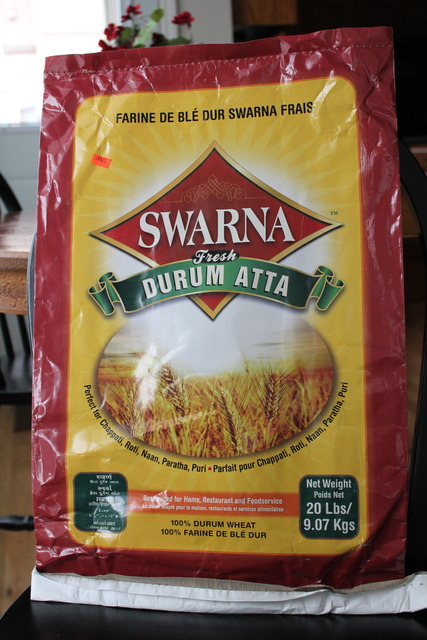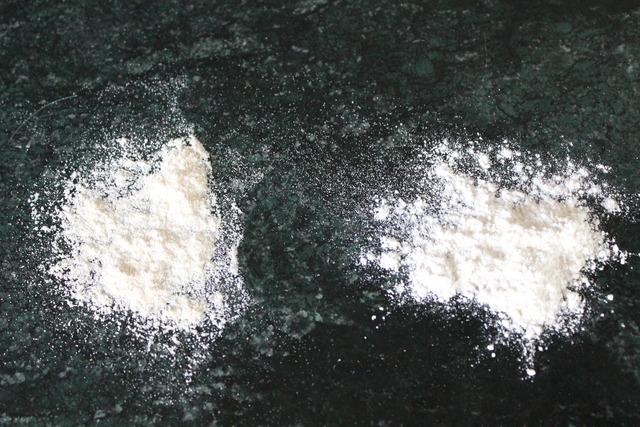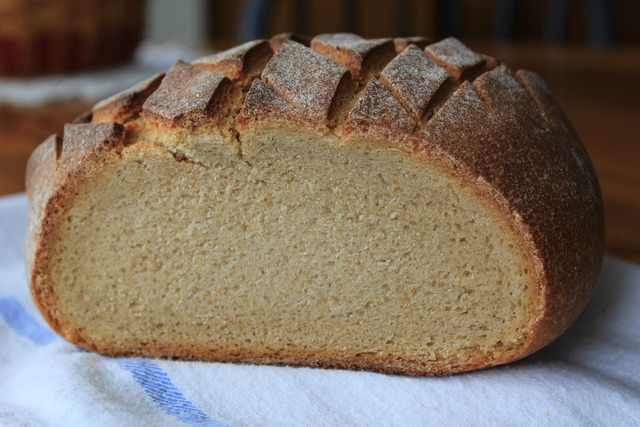
I've been interested for some time in playing around with durum flour. Between finding only the coarser semolina grind locally and being put off by the costs of mail ordering, I hadn't taken the plunge before now. However, totally by serendipity, I happened to be in an IndoPak grocery store recently and they had a whole shelf section of various atta flours, most milled from durum wheat. A 20-pound bag (only $12.99) followed me home and has been silently taunting me these past two weeks as other things kept me from baking. Nothing outlandish, mind you, but when a niece gets married she wants her doting aunt and uncle there even if they do live 5 states away.
The flour I purchased is Swarna Fresh Durum Atta, milled by a UAE company from wheat of an undisclosed country of origin:

The label says that it consists of 100% durum wheat. The nutritional information panel on the back of the bag lists the fiber content as 7g of a 100g sample, or 7%. I infer that to mean that this is a whole or nearly whole wheat flour. The items listed on the panel only total 92g, instead of 100g, so I'm not sure what else is there that didn't fit into the list of nutrients. Non-dietary fiber, perhaps?:

The flour's color, a pale tan with golden tones, would seem to support that supposition:

The durum atta is on the left, contrasted with an unbleached AP flour on the right. The atta flour has a slightly grittier feel when rubbed between thumb and forefinger. While the naked eye isn't always a reliable measuring tool, the particle size of the atta seems to be just slightly larger than the particle size of the AP flour.
So, what to do with this new-to-me flour? After much reading, Varda's Durum Atta Hearth Loaf formula from her post in 2011 looked like a good place to start. While handling the dough, I decided to make a small increase in hydration, from Varda's 60% up to 62%. Now that I've made it once, I'll probably experiment with nudging it up to 65% for a future bake. While I've read of durum's trait of absorbing more and more water right up to the point of releasing water from the dough, the fiber content in this is high enough that I think the dough will be alright. It may want a slightly longer autolyse but that will be a different experiment.
This dough, following Varda's instructions, handled nicely even though it was moderately stiff. Per instructions, I used no bench flour. There was only the slightest filming of dough residue on the countertop when kneading was finished.
I wound up having to extend the fermentation times slightly, while being mindful of the repeated mentions of durum's fermentation speed. It may have been that the starter was slightly sluggish last Saturday; it may have been the dough's stiffness. Whatever the cause(s), the dough was rather slow to inflate and I did not want to set myself up for an exploding loaf caused by under proofing. As it turned out, I could have let it go another 30 minutes or so, since there was some cracking of the crust. While I suspect that additional proofing would have helped, there is also the possibility that the durum's weaker gluten just would not tolerate much expansion.
The finished loaf has a lovely golden russet color:

The crumb is very tight, with a multitude of tiny bubbles, while exhibiting the golden tones that durum is known for:

The crumb is moister than the dough's handling characteristics would have suggested. A small amount of additional water still seems advisable. While it might look like pound cake, the crumb does require chewing. It isn't stiff but it is substantive. Considering the proportion of flour in each slice, relative to the air and water content, I guess that isn't a surprise. The flavor is very good. There's a richness that might make one suspect the addition of some oil or butter but it is a lean bread (which is not to say that some butter or oil wouldn't be a good addition). The sour notes are very mild. They meld with, rather than overpowering, the other flavors.
All in all, I am very pleased with this first attempt at a 100% durum loaf and very grateful to Varda for her trail-blazing efforts. It is definitely worthy of a repeat and I have plenty of flour left to play with.
Paul
- pmccool's Blog
- Log in or register to post comments
Great first attempt Paul. Durum is one of my favorite flours and I have made tons of recipes using it. I usually tend to mix in some other flours but have made a 100% version a few times as well. You can definitely up the hydration quite a bit, but use a long autolyse for about an hour to let the flour absorb in the water. I like to add some olive oil to soften the crumb a bit as well. You can search my posts on this site or on my blog at www.mookielovesbread.wordpress.com for dozens of recipes using Durum.
Regards,
Ian
There is plenty of experimenting ahead of me, so thank you for the information about durum breads on your blog. And thanks for the tips about enrichment and extending the autolyse.
Mr. Hamelman's Bread has a recipe or two, as well, that I need to try. There was also a durum sandwich loaf recipe that I found on-line which looks tempting. With 20 pounds of flour to play with, I have lots of options.
Baking with durum is kind of like venturing into rye breads in that there is this whole new world where things look familiar but turn out to be quite different.
Thanks,
Paul
I don;t usually use more than 50% durum but it can take way more than 62% hydration. i would go to at least 68% to open and lighten the crumb. When they mill the durum they sift out all the hard bits (atta) and then put some of it back in. It says 100% durum but it probably isn't 100% whole durum. I like to sift out the hard bits again and feed that to the starter first to make the levain and get the wettest the longest trying to soften them and help the crumb. Then you can regrind the remainder in a coffee grinder to cut the grit down some but this takes some time to not overheat it. A 1 hour autolyse is best with the higher hydration. You should be able to get into the mid 70's for hydration with this bread and maybe 80% if you pan it up. Nothing like the color and taste of durum.
20 pounds is a lot of durum for bread making so making 100%durum breads is the way to go :-) Might want to start making some pasta !
Happy durum baking
PS mini oven did a whole series of durum bakes in 2008-2009 that were very helpful i eventually got up to a 100% durum loaf at 100% hydration but it stuck to basket badly and wouldn't come out . was over proofed a bunch too with a 12 hour retard and durum proofing so fast... a Frisbee resulted but the bread tasted great and the holes were big.
http://www.thefreshloaf.com/node/30081/100-hydration-100-whole-grain-kamut-flat-boule-yw-and-sd-combo-starter
PSS - I suppose it might have been the YW that made the holes bigger than normal for a !00% whole grain durum. I think once you get the hydration right the holes will appear as they usually do:-)
just to see how the flour behaved on its own. While I don't feel constrained to use 100% durum flour for durum breads any more than I am constrained to use 100% rye flour for rye breads, it was a good learning exercise. There's value in doing some more bakes with the durum flour constituting 90-100% of the flour in the bread just to establish a baseline, too. Then I can start branching into other styles with lower durum percentages.
A definite yes to higher hydration for future breads. One of Hamelman's formulae is close to 90% hydration for a 90% durum/10% bread flour bread. I wasn't brave enough to tackle that on my first outing. One of these days, though...
This flour is milled finely enough that it will pass through the sieves I have, so no middlings to play with.
Yep, 20 pounds is enough to keep me busy for a while. And pasta is a distinct possibility.
Thanks for your suggestions.
Paul
It looks great. I just came home today with a bag of durum flour to start my own 'experiments'.
I just saw this great post. You got beautiful results with the atta, I must say. Since that long ago post, I have skipped the atta and bake with extra fancy durum which I believe produces a better bread. Nowadays, I make a 90% durum loaf, 80% hydration with yeast and white starter which gives the remaining 10% of flour. I sell a lot of this, but I also have to say that when people ask me what my favorite bread is, this wins hands down.
It's a winner regardless of flour.
Since I have it, I'll keep playing with the atta. If I can source the extra fancy durum at a reasonable price, then I will try that, too. It is good to know that you have moved up the hydration successfully. My attempt at Hamelman's formula came out well, so I am less gunshy than I was when I first started into the atta world.
Thank you for your comments.
Paul
The loaf looks really tasty! Never used ATTA but it is intriguing viz a viz globally sourced.
I also have used fancy durum in making bread. There are several sources. In the past I've sourced mine from Guisto's. However, I am a member of Los Angeles Bread Baker's Meetup. We routinely have flour orders. I currently obtain all my flour when the order listing comes up. I'd be happy to wrap up some extra fancy durum after the next order and mail it along. Please email me (I think I've listed it in my profile) and let me know if you would like this.
I'm still working my way through that first bag of flour, since I don't bake with the durum atta frequently. If I may, I'll take a raincheck for now and get in touch with you in the future about the extra fancy durum.
This weekend's bake included the durum atta as 25% of the flour bill. There's a mellow richness that the flour contributes which is quite unlike any other flour I've used. Good stuff!
Thanks again,
Paul